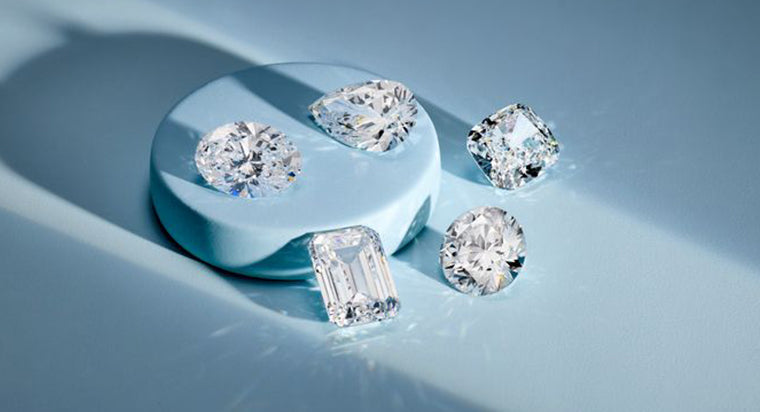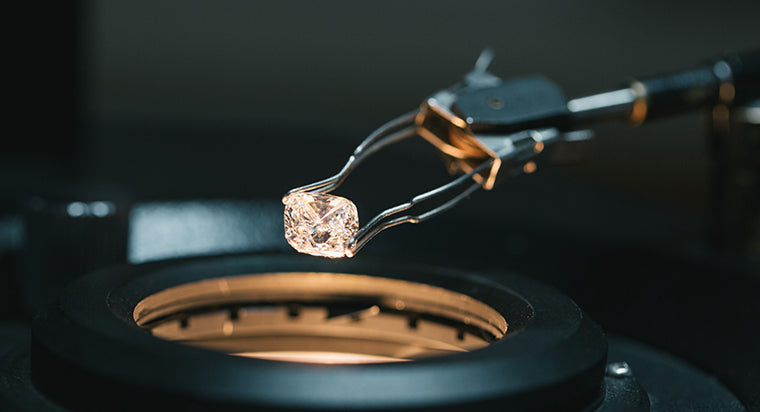What is Diamond Symmetry?
A diamond's finish contains two major elements: Polish & Symmetry. Symmetry is the arrangement, size, and shaping of diamond's facets. The facets are the flat planes that run along the surfaces of the diamond. Moreover, symmetry involves the angles and lines that form the placement of the facets. Nowadays, symmetry is completely controlled by the manufacturing process.
Machines very carefully cut diamonds to produce the most accurate shapes. However, at times the diamond cutter will leave a symmetry imperfection in the diamond in order to prevent a different inclusion from showing in the finished diamond. Symmetry is a subset of the diamond's cut grade. Moreover, symmetry grades refer to how carefully and cleanly diamond facets have been cut in relation to each other. Low symmetry grades can have a negative effect on a diamond's sparkle and its ability to hide inclusions.
While symmetry is not as crucial of an element in a diamond as the cut is, it can still make a different in the visual appearance of the diamond. However, it is important to avoid diamonds that have poor symmetry as this can be detrimental to the look of the diamond. Although symmetry is not as big of decider in the visual appearance, it can make a price difference of up to 15% between the various cut grades. Therefore, it can be a good characteristic to look at when comparing two diamonds that otherwise have the same cut grade and similar characteristics.
TABLE OF CONTENTS
Grading Scale
Like other diamond attributes, Symmetry is graded on a scale standardized by GIA (Gemological Institute of America), but can also be used by other laboratories like IGI (International Gemological Institute).

Excellent
The diamond's facets are perfectly sized and proportioned. The location of the diamond's attributes, such as culet, girdle table, etc. are in all the perfect locations. The diamond is not out of shape. The diamond can achieve an Excellent cut grade.

Very Good
The diamond's facet sizes and proportionately are near perfect. There may be one or two disproportionate elements that are viewed under 10px magnification. The impact on the diamond Cut grade and sparkle are minimal. The diamond can still achieve an Excellent cut grade.
Good
The size or location of attributes and facets is slightly disproportionate. The sparkle of the diamond is affected, as a result. The diamond can achieve a Very Good cut grade, at best.
Fair & Poor
The facets and proportionately are noticeably imperfect. In non-round shapes, the shaping is not perfect. The diamond's sparkle and brilliance are impacted adversely and the diamond can achieve, at best, a Good cut grade. A diamond with poor symmetry may misdirect light that travels into the diamond, sending it off at slightly wrong angles, and thereby reducing the diamond's brilliance.
More information on symmetry defects is listed below. The Symmetry Grade is based on the severity of these infractions.
Selecting a Symmetry Grade
Symmetry can add value to a diamond. Excellent symmetry grades carry a premium while Very Good and Good grades can have little to no visual effect when evaluated by the unaided eye. Therefore, Very Good and Good grade diamonds can be more budget friendly. Symmetry is generally considered a secondary factor behind cut grade. Despite its minor impact on appearance, symmetry has a significant impact on price; a diamond with Excellent Symmetry and Polish may be priced 5% - 10% higher than a diamond with Good Symmetry and Polish. This premium has more to do with consumer's perceived value of "excellent" grades, than the actual effect on a diamond's appearance. The difference is smaller in fancy shapes versus round cut diamonds.

Out of Round
The round cut diamond is not well shaped and the ratio of length to width is greater than 1.10.

Table off Center
The table facet at the top of the diamond is not perfectly center. The light performance of the diamond may be affected.

Culet off Center
The point at the bottom of the diamond is not directly centered. Light performance may be reduced in the diamond pavilion.

Table Culet Misalignment
The proportional locations of the tablet and cet are incorrect.

Crown and Pavilion Misalignment
The girdle points where the crown and pavilion facets should align are uneven. This can change the way light bounces in the diamond.

Wavy Girdle
The girdle isn't in the straight line around the diamond. This can affect the evenness of a diamond’s setting.

Misshapen Facets
The skit and triangular shaped facets are uneven and the pattern is not symmetrical. This affects the amount of light that enters each diamond facet.
FAQs
What is diamond symmetry?
How important is diamond symmetry?
Are grading systems the same for lab grown diamonds for symmetry?
How is symmetry graded?









